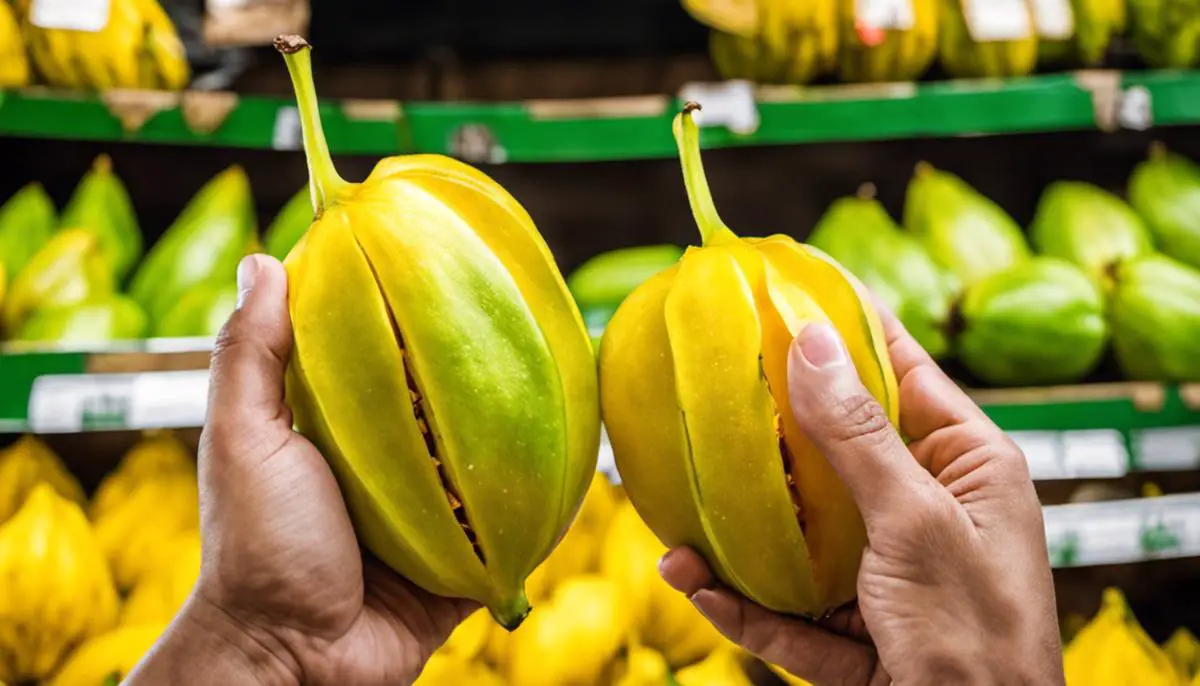Star fruit, or carambola, might seem strange and exotic, yet it’s an incredibly versatile and healthy addition to your diet. This star-shaped fruit, celebrated for its crisp texture and a taste that’s a delightful blend of sweet and tart, can glam up your meal within a moment. This discussion highlights everything you need to know about selecting, storing, preparing, and incorporating star fruit into your culinary creations. We will guide you through figuring out the perfect ripeness, the process of preparing this celestial named fruit, and divulge delectable recipes, along with underscoring the health benefits and necessary precautions associated with its consumption.
Selecting and Storing Star Fruit
Identifying a Ripe Star Fruit
To select a ripe star fruit in a grocery store, look for fruits with a bright yellow color without any green parts. The skin should be smooth and wax-like without any bruising or browning. Feel the fruit in your palm, it should yield slightly to gentle pressure, just like a ripe apple.
Understanding its Color and Taste
Star fruits are green when unripe and turn a bright yellow when they are ripe. Some may even have a slight tinge of brown on the edges, which is completely normal. Unripe, green star fruit can be quite sour, akin to green apples. When fully ripe, star fruits have a sweeter taste, with flavor notes reminiscent of plums, pineapples, and lemons.
Proper Storage for Extended Freshness
Storing the star fruit properly can extend its freshness. If you have a ripe star fruit that you aren’t ready to consume, it can be stored in the refrigerator for up to one week. Keep the fruit in a plastic bag or wrap it loosely with a paper towel and then put it inside a paper bag. These methods help to absorb any excess moisture and prevent the star fruit from losing its crispness.
If you need to store star fruit for a longer duration, you can consider freezing it. Cut the fruit into slices, keeping the star shape intact, and place them on a tray. Freeze them before transferring the frozen slices into a zip-top plastic bag. Remember to remove as much air as possible before sealing the bag, as this can prevent freezer burn.
Star fruits are best enjoyed fresh, so consume them shortly after purchasing for the best flavor and nutritional value. These delicate fruits can be cut into star-shaped slices and eaten raw, added to salads, or used as a unique garnish on dishes. Just remember, you can eat the entire star fruit, seeds and all.
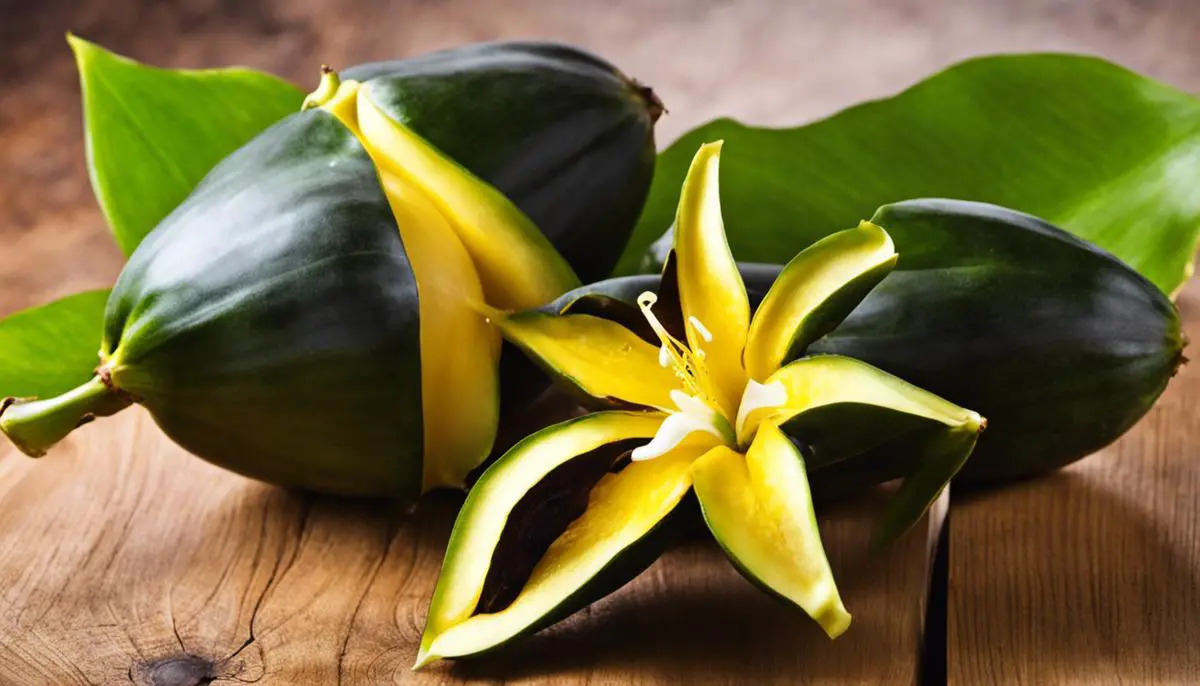
Preparing Star Fruit
Understanding Star Fruit: A Tropical Delight
Star fruit, also known as carambola, is a tropical fruit that’s gaining popularity in the United States. Known for its distinctive star shape when sliced, star fruit is rich in antioxidants, potassium, and vitamin C.
Is It Safe to Eat the Skin of Star Fruit?
Yes, the skin of the star fruit is edible. It’s not required to peel it before eating as the skin is thin, waxy, and full of nutrition. Always remember to wash it properly to remove any residue or dirt.
Cleaning and Washing the Star Fruit
To guarantee the fruit is safe for consumption, begin the process by washing your hands and cleaning your prep area. Hold the star fruit under running cool water and gently scrub the outside of the fruit. This will ensure it’s free from any unwanted debris or wax.
How to Cut and Deseed a Star Fruit
Start by laying the fruit on its side and cut off both ends with a sharp knife. Then, slice the fruit into even, star-shaped pieces, about half an inch thick. Each slice will reveal a beautiful star shape. Inside each point of the star, you’ll find a small seed which can be easily removed using the edge of your knife or a small spoon.
Identifying and Removing Unripe or Overly Ripe Parts
To get the maximum flavor from a star fruit, it’s important to understand how to recognize an unripe or overly ripe fruit. A ripe star fruit is firm, bright yellow with slightly brown edges. However, if it’s green, it’s unripe and if it has brown spots and feels mushy to touch, it’s overripe. You should remove and discard unripe or overly ripe parts before eating or incorporating into a dish.
Remember: unripe star fruit can have a sour taste, whereas an overly ripe fruit can be mushy and unpleasant. The best star fruit is that which has a nice balance of sweet and sour.
Now you’re ready to enjoy your star fruit!
Either eat it as is, toss it into a salad, use it as a garnish, incorporate into a fruit salad, or even blend it into a smoothie! Digesting the star fruit is essentially simple, and with these instructions, you can savor a healthy, unique, and refreshing fruit!
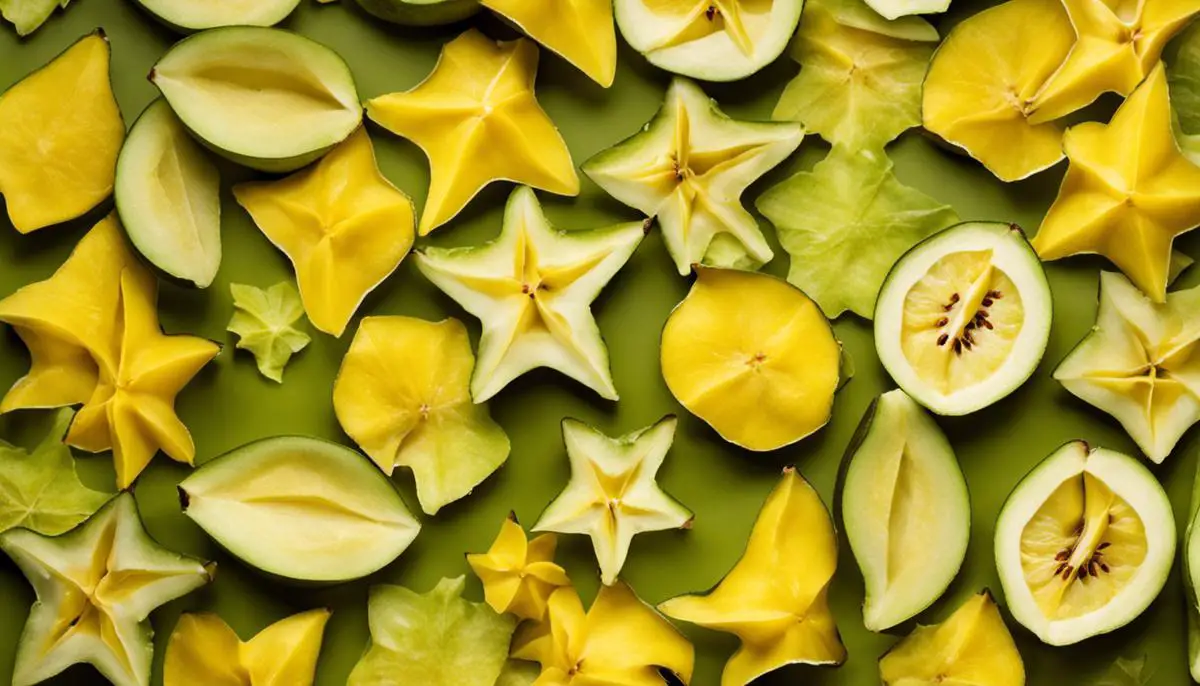
Using Star Fruit in Recipes
Learning about Star Fruit
Star fruit, also known as carambola, is a unique tropical fruit with a sweet and tangy flavor. This star-shaped fruit is a versatile ingredient and can be incorporated into a variety of recipes due to its unique flavor and texture.
Recipes with Star Fruit
Star fruit can be utilized in various dishes, from salads, desserts, and beverages, to even exotic savory dishes. One popular way to consume star fruit is to mix it into a fresh summer salad with some lettuce, avocados, cherry tomatoes, cucumber, and a light vinaigrette dressing. The fruit’s sweet yet tart flavor complements the fresh vegetables and enhances the overall eating experience.
In desserts, star fruit can add a special touch. Whether you’re making a tart, a pie, or a simple fruit salad, thinly sliced star fruit can bring a nice citrusy brightness to the overall flavor profile.
For beverages, consider incorporating star fruit into cocktails or mocktails. The star fruit can be juiced and mixed into drinks, or even sliced and used as a charming, edible garnish. It also creates a delicious tropical smoothie when blended with other fruits like pineapple, banana, or mango.
Balancing Star Fruit’s Tanginess in Food
While star fruit’s tanginess can be refreshing, it might sometimes overpower other ingredients in a dish. One way to harmonize its tangy taste is to pair it with mild savory foods like chicken, fish, or tofu. It also pairs well with dairy products such as cheese or cream, which can cut through the acidity and balance the flavors.
Moreover, the addition of sweetening agents such as honey, maple syrup, or sugar, can help in toning down the tanginess of the star fruit in desserts or beverages. But, always remember to adjust the amount of sweetener based on the tartness of the star fruit and your personal preference.
When using star fruit for the first time, start with small quantities to understand its flavor profile. Once you have a better understanding of its taste, you can experiment with different ingredients and determine your preferred flavor combinations. As a rule of thumb, always taste while cooking to ensure a balanced dish.
Cooking Exotic Dishes with Star Fruit
If you’re up for a culinary expedition, star fruit can also be incorporated into more exotic recipes. For instance, stuff a whole chicken with star fruit and herbs before roasting to create a tropical main course. You can also stir-fry thinly sliced star fruit with shrimp or tofu, garlic, chili peppers, and your favorite Asian sauce for an unconventional yet mouthwatering dish. The star fruit’s inherent tanginess adds a new dimension to these savory dishes.
Remember, the potential uses for star fruit are limited only by your imagination. So don’t hesitate to experiment and discover your unique way of enjoying this exciting, star-shaped fruit.
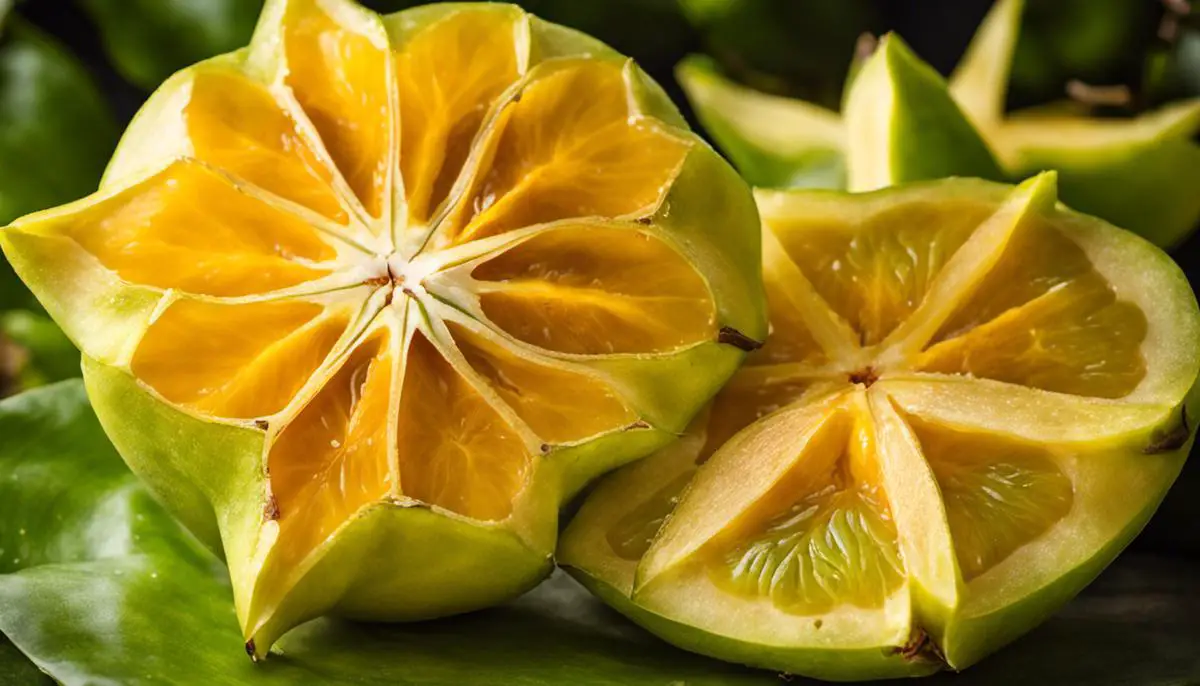
Health Benefits and Cautions
The Nutritional Value and Health Benefits of Star Fruit
Star fruit, also known as carambola, is a tropical fruit that is rich in antioxidants, vitamins, and minerals. A single serving of star fruit can offer a significant portion of your daily vitamin C requirement, boosting your immunity. The fruit is also a good source of dietary fiber, which aids in digestion and helps maintain a healthy weight. Additionally, star fruit contains B-vitamins, specifically B5 and folate, that help the body metabolize proteins, fats, and carbohydrates.
The fruit also boasts a high water content, making it a refreshing and hydrating snack. The antioxidant properties of star fruit may help fight inflammation and oxidative stress, both of which are associated with chronic illnesses. Moreover, star fruit is low in calories, yet high in dietary fiber, making it an ideal snack for those looking to manage their weight.
Who Should Avoid Consuming Star Fruit and Why?
While star fruit is a healthy addition to most diets, people with certain health conditions should avoid it. These conditions primarily concern the kidneys. Star fruit contains a toxin that healthy kidneys can filter out. However, for people with kidney disease or compromised renal function, this same toxin can build up, leading to potentially serious neurological complications.
Star fruit is also high in oxalates, making it a food to avoid for those with a history of calcium-oxalate kidney stones. The fruit’s high potassium levels can further complicate health issues in people with kidney disease, as their kidneys might not effectively remove excess potassium.
Moreover, star fruit is naturally high in fructose, a type of sugar that can have negative effects on those with fructose intolerance. Accordingly, people who suffer from this condition should also avoid consuming star fruit.
Furthermore, individuals who are on prescription medications, particularly statins and opiates, must exercise caution when consuming star fruit. The fruit is known to interact with these medications, potentially leading to adverse effects.
As with any dietary change or for people with chronic health conditions, it is always best to consult with a healthcare professional before incorporating star fruit into the diet.
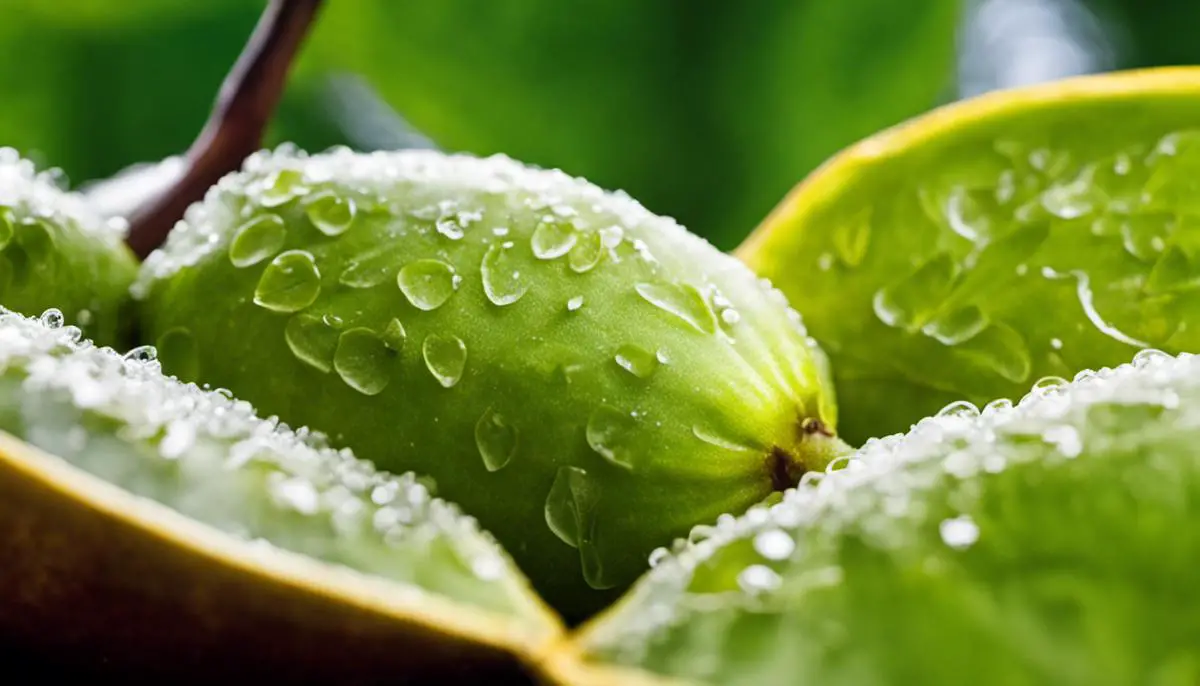
Indeed, star fruit is a celestial body in the universe of produce, bringing a bright light to your health and table. Its unique flavour and texture can be a delightful addition to numerous recipes. However, although it is packed with health benefits, it’s essential to remember the cautionary notes about who should consume it sparingly or avoid altogether due to its high oxalic acid content. With knowledge in your arsenal about how to choose, store, prepare, and use star fruit, you’re now ready to add it to your diet and explore its constellation of tastes and benefits.
